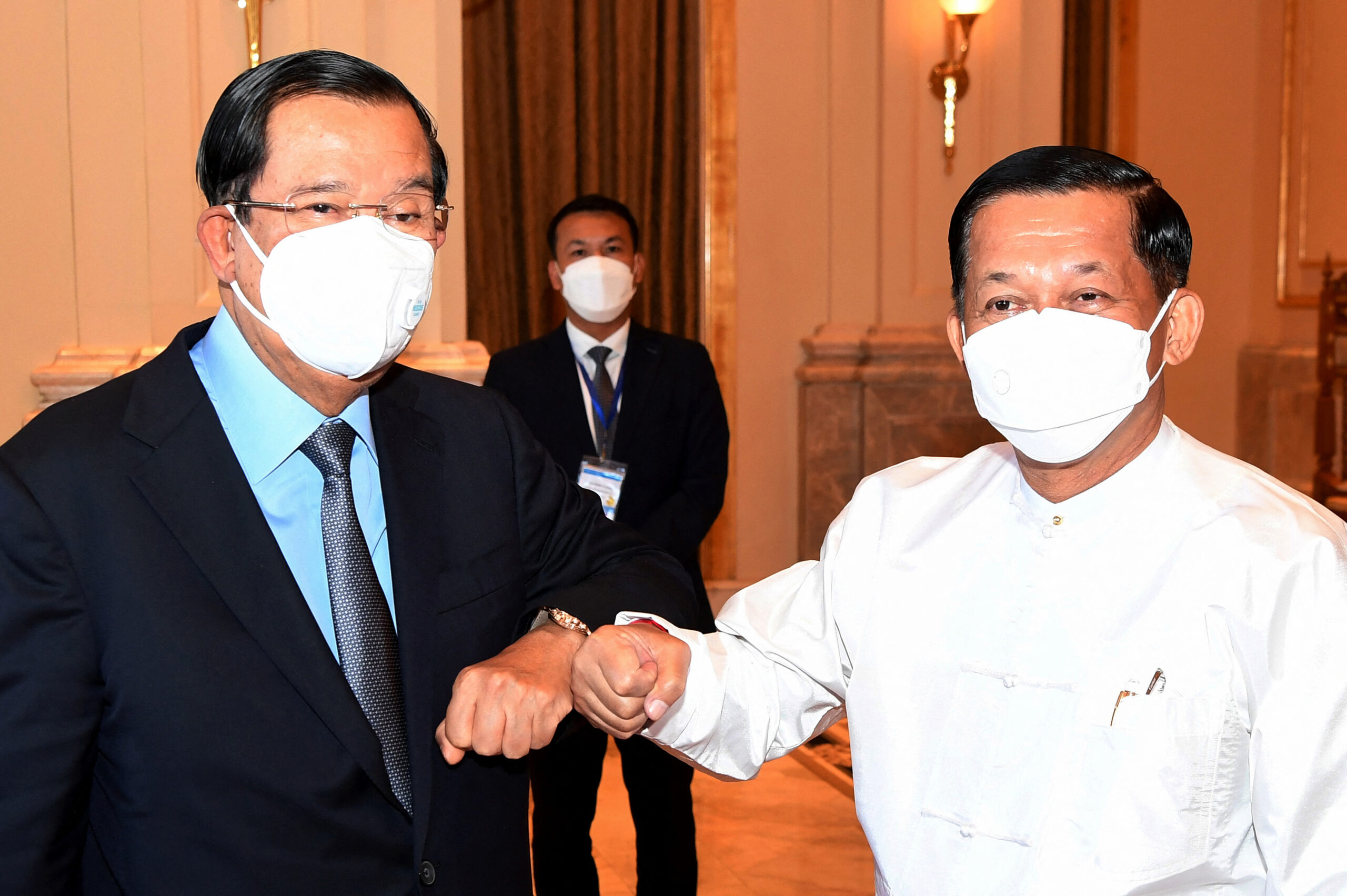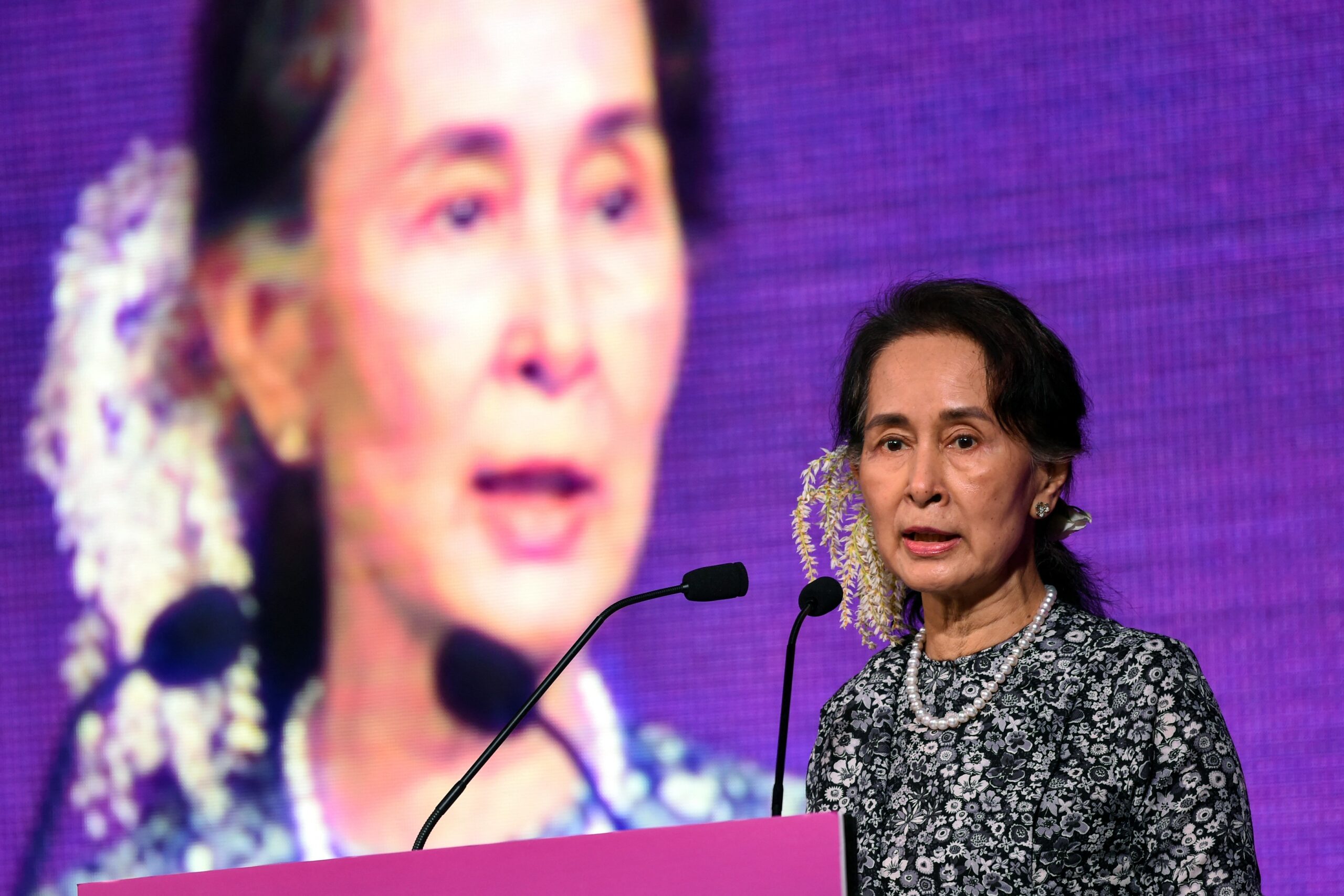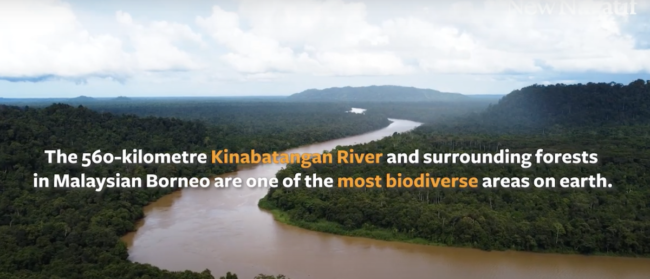Cambodian prime minister Hun Sen became the first head of state to meet with Min Aung Hlaing since the February 2021 coup that brought the military leader and his State Administrative Council (SAC) to power in Myanmar.
Their meeting on 7 January was bracketed by protests. First by Myanmar citizens and anti-coup elements opposed to the legitimacy such a visit would grant the SAC. Later by other members of the Association of Southeast Asian Nations (ASEAN), most notably Malaysia and Singapore, which appear to be irked that Hun Sen would make a trip in his capacity as the ASEAN chairperson not long after the organisation barred the SAC from its meetings.
In the delicate work of security issues within a consensus-based organisation such as ASEAN, Cambodia can appear to be a saboteur.
There is legitimate cause for ASEAN member states to be upset with the visit, or even suspicious of Cambodia’s intentions. If Malaysia’s foreign minister Saifuddin Abdullah is to be believed, ASEAN was not consulted before its own chair made the trip from Cambodia to Myanmar.
Despite some members of the ten-nation organisation expressing hopes to discuss the matter at an upcoming summit, Hun Sen apparently decided to force the issue and perform a fait accompli ahead of further discussion.
The next meeting of ASEAN foreign ministers has been delayed indefinitely, almost certainly due to this incident. This effectively pushes back the schedule on multiple ASEAN engagements. Regardless of the perception of Hun Sen’s trip, Cambodia’s actions clearly caused a real split among ASEAN members and threw a wrench into ASEAN’s 2022 agenda.
To some, this is another data point in a long trend of Cambodian abuse of the chairmanship.
A recent precedent is stonewalling the 2012 ASEAN foreign ministers meeting over adding language about the South China Sea to the summit’s joint statement. The meeting ended without any joint statement, an embarrassing first in ASEAN history. A similar dynamic played out in 2016, although Cambodia wasn’t the chair that time.
Not every ASEAN member state sees the Myanmar trip in a negative light. Laos and Vietnam have given full-throated approval, calling Hun Sen’s trip necessary for the full implementation of the Five-Point Consensus ASEAN issued during its last summit.
Singapore prime minister Lee Hsien Loong has voiced his disapproval, insisting Myanmar continue to be excluded from ASEAN meetings. But others agreed with Hun Sen’s approach, notably former Singapore ambassador Bilahari Kausikan, who wrote publicly about his support for the trip. Bilahari Kausikan does not typically mince words about Cambodia’s conduct within ASEAN, as exhibited when he recounted his experience of the 2012 impasse.
There is not actually as much opposition to Cambodia’s agenda as some may think. The latest split is primarily over the very thing on which all supporters and detractors within ASEAN agree: the Five-Point Consensus.

Important Points
The consensus articulates what ASEAN members want to see before Myanmar’s military government can join its ranks. The terms include an immediate ceasefire, earnest dialogue between the SAC and the opposition with Myanmar and a means for ASEAN to deliver humanitarian aid to civilians. In return, the ASEAN chair would appoint a special envoy to mediate between Myanmar’s warring sides and send a delegation to meet all parties in the conflict.
The dividing line on Hun Sen’s trip is thus based on how seriously ASEAN member states take the Five-Points Consensus, including whether the points need to be met before SAC can rejoin the group or if members believe ensuring implementation is best done through engagement with Myanmar’s junta at all costs.
The former position, emphasising compliance before engagement, is perhaps best summed up by Indonesia’s straightforward reaction to Hun Sen’s diplomatic trip. President Joko Widodo stated on social media that dialogue between ASEAN and the junta should be conditioned on the SAC fulfilling the Five-Point Consensus.
The latter position, on engagement before compliance, appears to be held by Cambodia, Laos and Vietnam. As chair, Cambodia has touted results from its meeting including additional humanitarian aid to Myanmar, permission for the ASEAN special envoy to act as a mediator in ceasefire talks and a five-month ceasefire between the Myanmar military and opposing Ethnic Armed Organizations (EAO).
These may tick boxes on the Five-Point Consensus. But on closer inspection there are reasons to doubt any meaningful progress has been made to resolve the Myanmar issue at all.
The SAC apparently agreed to a ceasefire with opposing EAO, which would be in accordance with important points of the consensus. But the sincerity of Min Aung Hlaing is in doubt.
Since early October the military has been engaged in a brutal offensive in the country’s northwest region, with a documented pattern of atrocities in Chin State, including arson and mutilation of suspected rebels. After the ceasefire was announced, the Myanmar military conducted airstrikes against insurgents and civilians in the Sagaing Region on 15 January, proving the northwest offensive has not really stopped.
This violence is expected to continue because the junta was careful to announce a ceasefire with only EAO, groups that are actually just one of several factions opposing the military’s rule.
No similar ceasefire was announced between the junta’s forces and the National Unity Government (NUG), which represents the elected but short-lived democratic government. Nor is there a ceasefire between the junta and the People’s Defense Forces (PDF), a network of armed insurgents resisting the SAC.
For true dialogue, a ceasefire would be needed with all elements of the SAC’s opposition, which Cambodia couldn’t secure. A ceasefire with EAO may seem to be a partial goal, but this was technically within the junta’s interest anyway.
The Myanmar armed forces believe in the strategic usage of ceasefires with different armed groups to split the opposition. In the most recent bout of fighting, the army clarified its ultimate intent to split EAO from the NUG and PDF due to the threat posed by continued EAO training and materiel support to PDF.
Similarly the ASEAN special envoy will be able to meet with EAO and the SAC directly, but was denied the right to meet with any NUG representatives or its primary leader, Aung San Suu Kyi, whom the SAC is keeping in prison.

Regardless of what one considers the best strategy for engaging with Myanmar, the junta was not meeting the consensus points in a meaningful way before Hun Sen’s visit. Proponents of engagement also need to acknowledge very little progress will be made as a result of the visit. Ultimately, success comes down to whether marginal gains are better than none.
For Cambodia, those small gains can be noted as signs of progress under its leadership. The previous ASEAN chair, Brunei, insisted on meeting with all sides in the conflict, including Suu Kyi and the NUG. Brunei’s strong line in the sand was unsuccessful and Cambodia’s preference for a different tack is thus not surprising.
Cambodia does not appear to be purposely sabotaging ASEAN. It has undoubtedly angered other ASEAN members and wielded its chairmanship in a non-consultative, reckless manner, but this sprung from a disagreement on how to handle the issue. And at least some ASEAN states are on Cambodia’s side.
Going forward, focus should be on whether Cambodia will continue to use insincere, marginal pledges by the SAC to justify greater engagement, indicating Phnom Penh considers the consensus more of a nuisance than a productive negotiating blueprint.
Cambodia should also be judged on whether it prominently rebuffs the junta at some point for failing or going back on one of its promises, perhaps by denying the SAC a seat at another ASEAN summit or by cancelling a subsequent visit.
In either scenario, Cambodia will not likely have a consensus behind its actions, due to the issue’s divisive nature. But there is now enough precedent for the rest of Southeast Asia to understand Cambodia doesn’t care.
Drake Long is a member of the Pacific Forum Young Leader programme who has written about Southeast Asia security issues for various publications. He holds a master’s degree in conflict resolution from Georgetown University and a bachelor’s degree from Miami University of Ohio.


